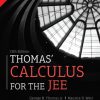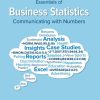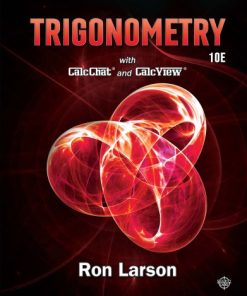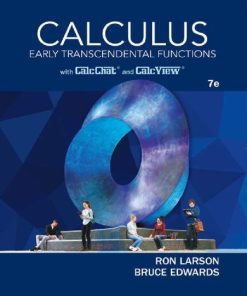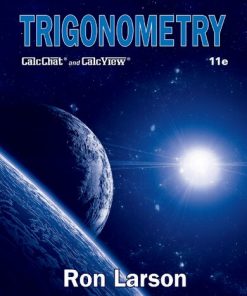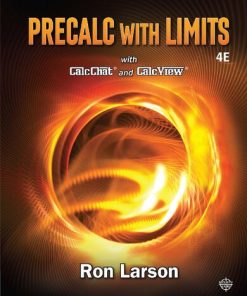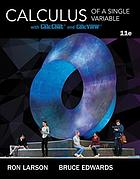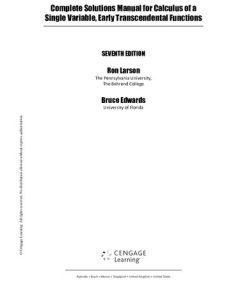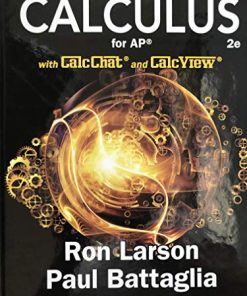Calculus with calcChat Calcview 12th Edition by Ron Larson, Bruce Edwards 8214119847 9798214119847
$50.00 Original price was: $50.00.$25.00Current price is: $25.00.
Calculus with calcChat Calcview 12th Edition by Ron Larson, Bruce H. Edwards – Ebook PDF Instant Download/DeliveryISBN: 8214119847, 9798214119847
Full download Calculus with calcChat Calcview 12th Edition after payment.
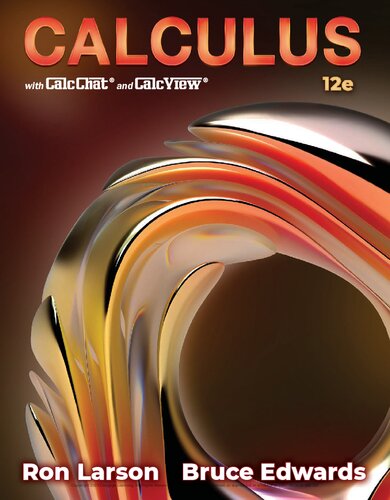
Product details:
ISBN-10 : 8214119847
ISBN-13 : 9798214119847
Author : Ron Larson, Bruce H. Edwards
Clearly present and effectively demonstrate the concepts and rules of calculus with the student-focused approach in CALCULUS, 12th Edition by award-winning authors Larson and Edwards. This edition offers a wealth of learning support and digital resources — all thoroughly updated and refined using proven learning design principles that remove typical barriers to learning to create a carefully planned, inclusive experience for all students. New “Big Ideas of Calculus” notes highlight overarching ideas behind chapter topics, while annotated examples, “Concept Checks” and visually driven exercises help students master key concepts. New automatically graded Proof Problems, Expanded Problems and “Explore It” interactive learning modules within WebAssign digital resources help students develop a deeper conceptual understanding as they apply concepts. In addition, CalcView.com, CalcChat.com and LarsonCalculus.com offer tutorial support to further your students’ understanding.
Important Notice: Media content referenced within the product description or the product text may not be available in the ebook version.
Calculus with calcChat Calcview 12th Table of contents:
P. Preparation for Calculus
P.1. Graphs and Models
The Graph of an Equation
Intercepts of a Graph
Symmetry of a Graph
Points of Intersection
Mathematical Models
P.1. Exercises
P.2. Linear Models and Rates of Change
The Slope of a Line
Equations of Lines
Ratios and Rates of Change
Graphing Linear Models
Parallel and Perpendicular Lines
P.2. Exercises
P.3. Functions and Their Graphs
Functions and Function Notation
The Domain and Range of a Function
The Graph of a Function
Transformations of Functions
Classifications and Combinations of Functions
P.3. Exercises
P.4. Review of Trigonometric Functions
Angles and Degree Measure
Radian Measure
The Trigonometric Functions
Evaluating Trigonometric Functions
Solving Trigonometric Equations
Graphs of Trigonometric Functions
P.4. Exercises
Review Exercises
P.S. Problem Solving
1. Limits and Their Properties
1.1. A Preview of Calculus
What Is Calculus?
The Tangent Line Problem
The Area Problem
1.1. Exercises
1.2. Finding Limits Graphically and Numerically
An Introduction to Limits
Limits That Fail to Exist
A Formal Definition of Limit
1.2. Exercises
1.3. Evaluating Limits Analytically
Properties of Limits
A Strategy for Finding Limits
Dividing Out Technique
Rationalizing Technique
The Squeeze Theorem
1.3. Exercises
1.4. Continuity and One-Sided Limits
Continuity at a Point and on an Open Interval
One-Sided Limits and Continuity on a Closed Interval
Properties of Continuity
The Intermediate Value Theorem
1.4. Exercises
1.5. Infinite Limits
Infinite Limits
Vertical Asymptotes
1.5. Exercises
Section Project. Graphs and Limits of Trigonometric Functions
Review Exercises
P.S. Problem Solving
2. Differentiation
2.1. The Derivative and the Tangent Line Problem
The Tangent Line Problem
The Derivative of a Function
Differentiability and Continuity
2.1. Exercises
2.2. Basic Differentiation Rules and Rates of Change
The Constant Rule
The Power Rule
The Constant Multiple Rule
The Sum and Difference Rules
Derivatives of the Sine and Cosine Functions
Rates of Change
2.2. Exercises
2.3. Product and Quotient Rules and Higher-Order Derivatives
The Product Rule
The Quotient Rule
Derivatives of Trigonometric Functions
Higher-Order Derivatives
2.3. Exercises
2.4. The Chain Rule
The Chain Rule
The General Power Rule
Simplifying Derivatives
Trigonometric Functions and the Chain Rule
2.4. Exercises
2.5. Implicit Differentiation
Implicit and Explicit Functions
Implicit Differentiation
2.5. Exercises
Section Project. Optical Illusions
2.6. Related Rates
Finding Related Rates
Problem Solving with Related Rates
2.6. Exercises
Review Exercises
P.S. Problem Solving
3. Applications of Differentiation
3.1. Extrema on an Interval
Extrema of a Function
Relative Extrema and Critical Numbers
Finding Extrema on a Closed Interval
3.1. Exercises
3.2. Rolle’s Theorem and the Mean Value Theorem
Rolle’s Theorem
The Mean Value Theorem
3.2. Exercises
3.3. Increasing and Decreasing Functions and the First Derivative Test
Increasing and Decreasing Functions
The First Derivative Test
3.3. Exercises
Section Project. Even Polynomial Functions of Fourth Degree
3.4. Concavity and the Second Derivative Test
Concavity
Points of Inflection
The Second Derivative Test
3.4. Exercises
3.5. Limits at Infinity
Limits at Infinity
Horizontal Asymptotes
Infinite Limits at Infinity
3.5. Exercises
3.6. A Summary of Curve Sketching
Analyzing the Graph of a Function
3.6. Exercises
3.7. Optimization Problems
Applied Minimum and Maximum Problems
3.7. Exercises
Section Project. Minimum Time
3.8. Newton’s Method
Newton’s Method
3.8. Exercises
3.9. Differentials
Tangent Line Approximations
Differentials
Error Propagation
Calculating Differentials
3.9. Exercises
Review Exercises
P.S. Problem Solving
4. Integration
4.1. Antiderivatives and Indefinite Integration
Antiderivatives
Basic Integration Rules
Initial Conditions and Particular Solutions
4.1. Exercises
4.2. Area
Sigma Notation
Area
The Area of a Plane Region
Finding Area by the Limit Definition
4.2. Exercises
4.3. Riemann Sums and Definite Integrals
Riemann Sums
Definite Integrals
Properties of Definite Integrals
4.3. Exercises
4.4. The Fundamental Theorem of Calculus
The Fundamental Theorem of Calculus
The Mean Value Theorem for Integrals
Average Value of a Function
The Second Fundamental Theorem of Calculus
Net Change Theorem
4.4. Exercises
4.5. Integration by Substitution
Pattern Recognition
Change of Variables for Indefinite Integrals
The General Power Rule for Integration
Change of Variables for Definite Integrals
Integration of Even and Odd Functions
4.5. Exercises
Section Project . Probability
Review Exercises
P.S. Problem Solving
5. Logarithmic, Exponential, and Other Transcendental Functions
5.1. The Natural Logarithmic Function: Differentiation
The Natural Logarithmic Function
The Number e
The Derivative of the Natural Logarithmic Function
5.1. Exercises
5.2. The Natural Logarithmic Function: Integration
Log Rule for Integration
Integrals of Trigonometric Functions
5.2. Exercises
5.3. Inverse Functions
Inverse Functions
Existence of an Inverse Function
Derivative of an Inverse Function
5.3. Exercises
5.4. Exponential Functions: Differentiation and Integration
The Natural Exponential Function
Derivatives of Exponential Functions
Integrals of Exponential Functions
5.4. Exercises
5.5. Bases Other than e and Applications
Bases Other than e
Differentiation and Integration
Applications of Exponential Functions
5.5. Exercises
Section Project. Using a Graphing Utility to Estimate Slope
5.6. Indeterminate Forms and L’Hôpital’s Rule
Indeterminate Forms
L’Hôpital’s Rule
5.6. Exercises
5.7. Inverse Trigonometric Functions: Differentiation
Inverse Trigonometric Functions
Derivatives of Inverse Trigonometric Functions
Review of Basic Differentiation Rules
5.7. Exercises
5.8. Inverse Trigonometric Functions: Integration
Integrals Involving Inverse Trigonometric Functions
Completing the Square
Review of Basic Integration Rules
5.8. Exercises
5.9. Hyperbolic Functions
Hyperbolic Functions
Differentiation and Integration of Hyperbolic Functions
Inverse Hyperbolic Functions
Inverse Hyperbolic Functions: Differentiation and Integration
5.9. Exercises
Section Project. Mercator Map
Review Exercises
P.S. Problem Solving
6. Differential Equations
6.1. Slope Fields and Euler’s Method
General and Particular Solutions
Slope Fields
Euler’s Method
6.1. Exercises
6.2. Growth and Decay
Differential Equations
Growth and Decay Models
6.2. Exercises
6.3. Separation of Variables and the Logistic Equation
Separation of Variables
Applications
Logistic Differential Equation
6.3. Exercises
6.4. First-Order Linear Differential Equations
First-Order Linear Differential Equations
6.4. Exercises
Section Project. Weight Loss
Review Exercises
P.S. Problem Solving
7. Applications of Integration
7.1. Area of a Region Between Two Curves
Area of a Region Between Two Curves
Area of a Region Between Intersecting Curves
Integration as an Accumulation Process
7.1. Exercises
7.2. Volume: The Disk Method
The Disk Method
The Washer Method
Solids with Known Cross Sections
7.2. Exercises
7.3. Volume: The Shell Method
The Shell Method
Comparison of Disk and Shell Methods
7.3. Exercises
Section Project. Saturn
7.4. Arc Length and Surfaces of Revolution
Arc Length
Area of a Surface of Revolution
7.4. Exercises
7.5. Work
Work Done by a Constant Force
Work Done by a Variable Force
7.5. Exercises
Section Project. Pyramid of Khufu
7.6. Moments, Centers of Mass, and Centroids
Mass
Center of Mass in a One-Dimensional System
Center of Mass in a Two-Dimensional System
Center of Mass of a Planar Lamina
Theorem of Pappus
7.6. Exercises
7.7. Fluid Pressure and Fluid Force
Fluid Pressure and Fluid Force
7.7. Exercises
Review Exercises
P.S. Problem Solving
8. Integration Techniques and Improper Integrals
8.1. Basic Integration Rules
Fitting Integrands to Basic Integration Rules
8.1. Exercises
8.2. Integration by Parts
Integration by Parts
8.2. Exercises
8.3. Trigonometric Integrals
Integrals Involving Powers of Sine and Cosine
Integrals Involving Powers of Secant and Tangent
Integrals Involving Sines and Cosines of Two Angles
8.3. Exercises
Section Project. The Wallis Product
8.4. Trigonometric Substitution
Trigonometric Substitution
Applications
8.4. Exercises
8.5. Partial Fractions
Partial Fractions
Linear Factors
Quadratic Factors
8.5. Exercises
8.6. Numerical Integration
The Trapezoidal Rule
Simpson’s Rule
Error Analysis
8.6. Exercises
8.7. Integration by Tables and Other Integration Techniques
Integration by Tables
Reduction Formulas
Fractional Expressions of Sine and Cosine
8.7. Exercises
8.8. Improper Integrals
Improper Integrals with Infinite Limits of Integration
Improper Integrals with Infinite Discontinuities
8.8. Exercises
Review Exercises
P.S. Problem Solving
9. Infinite Series
9.1. Sequences
Sequences
Limit of a Sequence
Pattern Recognition for Sequences
Monotonic Sequences and Bounded Sequences
9.1. Exercises
9.2. Series and Convergence
Infinite Series
Geometric Series
n th-Term Test for Divergence
9.2. Exercises
Section Project. Cantor’s Disappearing Table
9.3. The Integral Test and p -Series
The Integral Test
p -Series and Harmonic Series
9.3. Exercises
Section Project. The Harmonic Series
9.4. Comparisons of Series
Direct Comparison Test
Limit Comparison Test
9.4. Exercises
9.5. Alternating Series
Alternating Series Test
Alternating Series Remainder
Absolute and Conditional Convergence
Rearrangement of Series
9.5. Exercises
9.6. The Ratio and Root Tests
The Ratio Test
The Root Test
Guidelines for Testing Series
9.6. Exercises
9.7. Taylor Polynomials and Approximations
Polynomial Approximations of Elementary Functions
Taylor and Maclaurin Polynomials
Remainder of a Taylor Polynomial
9.7. Exercises
9.8. Power Series
Power Series
Radius and Interval of Convergence
Endpoint Convergence
Differentiation and Integration of Power Series
9.8. Exercises
9.9. Representation of Functions by Power Series
Geometric Power Series
Operations with Power Series
9.9. Exercises
9.10. Taylor and Maclaurin Series
Taylor Series and Maclaurin Series
Binomial Series
Deriving Taylor Series from a Basic List
9.10. Exercises
Review Exercises
P.S. Problem Solving
10. Conics, Parametric Equations, and Polar Coordinates
10.1. Conics and Calculus
Conic Sections
Parabolas
Ellipses
Hyperbolas
10.1. Exercises
10.2. Plane Curves and Parametric Equations
Plane Curves and Parametric Equations
Eliminating the Parameter
Finding Parametric Equations
The Tautochrone and Brachistochrone Problems
10.2. Exercises
Section Project. Cycloids
10.3. Parametric Equations and Calculus
Slope and Tangent Lines
Arc Length
Area of a Surface of Revolution
10.3. Exercises
10.4. Polar Coordinates and Polar Graphs
Polar Coordinates
Coordinate Conversion
Polar Graphs
Slope and Tangent Lines
Special Polar Graphs
10.4. Exercises
Section Project. Cassini Oval
10.5. Area and Arc Length in Polar Coordinates
Area of a Polar Region
Points of Intersection of Polar Graphs
Arc Length in Polar Form
Area of a Surface of Revolution
10.5. Exercises
10.6. Polar Equations of Conics and Kepler’s Laws
Polar Equations of Conics
Kepler’s Laws
10.6. Exercises
Review Exercises
P.S. Problem Solving
11. Vectors and the Geometry of Space
11.1. Vectors in the Plane
Component Form of a Vector
Vector Operations
Standard Unit Vectors
11.1. Exercises
11.2. Space Coordinates and Vectors in Space
Coordinates in Space
Vectors in Space
11.2. Exercises
11.3. The Dot Product of Two Vectors
The Dot Product
Angle Between Two Vectors
Direction Cosines
Projections and Vector Components
Work
11.3. Exercises
11.4. The Cross Product of Two Vectors in Space
The Cross Product
The Triple Scalar Product
11.4. Exercises
11.5. Lines and Planes in Space
Lines in Space
Planes in Space
Sketching Planes in Space
Distances Between Points, Planes, and Lines
11.5. Exercises
Section Project. Distances in Space
11.6. Surfaces in Space
Cylindrical Surfaces
Quadric Surfaces
Surfaces of Revolution
11.6. Exercises
11.7. Cylindrical and Spherical Coordinates
Cylindrical Coordinates
Spherical Coordinates
11.7. Exercises
Review Exercises
P.S. Problem Solving
12. Vector-Valued Functions
12.1. Vector-Valued Functions
Space Curves and Vector-Valued Functions
Limits and Continuity
12.1. Exercises
Section Project. Witch of Agnesi
12.2. Differentiation and Integration of Vector-Valued Functions
Differentiation of Vector-Valued Functions
Integration of Vector-Valued Functions
12.2. Exercises
12.3. Velocity and Acceleration
Velocity and Acceleration
Projectile Motion
12.3. Exercises
12.4. Tangent Vectors and Normal Vectors
Tangent Vectors and Normal Vectors
Tangential and Normal Components of Acceleration
12.4. Exercises
12.5. Arc Length and Curvature
Arc Length
Arc Length Parameter
Curvature
Application
12.5. Exercises
Review Exercises
P.S. Problem Solving
13. Functions of Several Variables
13.1. Introduction to Functions of Several Variables
Functions of Several Variables
The Graph of a Function of Two Variables
Level Curves
Level Surfaces
Graphing Utilities and Surfaces
13.1. Exercises
13.2. Limits and Continuity
Neighborhoods in the Plane
Limit of a Function of Two Variables
Continuity of a Function of Two Variables
Continuity of a Function of Three Variables
13.2. Exercises
13.3. Partial Derivatives
Partial Derivatives of a Function of Two Variables
Partial Derivatives of a Function of Three or More Variables
Higher-Order Partial Derivatives
13.3. Exercises
13.4. Differentials
Increments and Differentials
Differentiability
Approximation by Differentials
13.4. Exercises
13.5. Chain Rules for Functions of Several Variables
Chain Rules for Functions of Several Variables
Implicit Partial Differentiation
13.5. Exercises
13.6. Directional Derivatives and Gradients
Directional Derivative
The Gradient of a Function of Two Variables
Applications of the Gradient
Functions of Three Variables
13.6. Exercises
13.7. Tangent Planes and Normal Lines
Tangent Plane and Normal Line to a Surface
The Angle of Inclination of a Plane
A Comparison of the Gradients ∇ f ( x , y ) and ∇ F ( x , y , z )
13.7. Exercises
Section Project. Wildflowers
13.8. Extrema of Functions of Two Variables
Absolute Extrema and Relative Extrema
The Second Partials Test
13.8. Exercises
13.9. Applications of Extrema
Applied Optimization Problems
The Method of Least Squares
13.9. Exercises
Section Project. Building a Pipeline
13.10. Lagrange Multipliers
Lagrange Multipliers
Constrained Optimization Problems
The Method of Lagrange Multipliers with Two Constraints
13.10. Exercises
Review Exercises
P.S. Problem Solving
14. Multiple Integration
14.1. Iterated Integrals and Area in the Plane
Iterated Integrals
Area of a Plane Region
14.1. Exercises
14.2. Double Integrals and Volume
Double Integrals and Volume of a Solid Region
Evaluation of Double Integrals
Average Value of a Function
14.2. Exercises
14.3. Change of Variables: Polar Coordinates
Double Integrals in Polar Coordinates
14.3. Exercises
14.4. Center of Mass and Moments of Inertia
Mass
Moments and Center of Mass
Moments of Inertia
14.4. Exercises
Section Project. Center of Pressure on a Sail
14.5. Surface Area
Surface Area
14.5. Exercises
Section Project. Surface Area in Polar Coordinates
14.6. Triple Integrals and Applications
Triple Integrals
Center of Mass and Moments of Inertia
14.6. Exercises
14.7. Triple Integrals in Other Coordinates
Triple Integrals in Cylindrical Coordinates
Triple Integrals in Spherical Coordinates
14.7. Exercises
Section Project. Wrinkled and Bumpy Spheres
14.8. Change of Variables: Jacobians
Jacobians
Change of Variables for Double Integrals
14.8. Exercises
Review Exercises
P.S. Problem Solving
15. Integration
15.1. Vector Fields
Vector Fields
Conservative Vector Fields
Curl of a Vector Field
Divergence of a Vector Field
15.1. Exercises
15.2. Line Integrals
Piecewise Smooth Curves
Line Integrals
Line Integrals of Vector Fields
Line Integrals in Differential Form
15.2. Exercises
15.3. Conservative Vector Fields and Independence of Path
Fundamental Theorem of Line Integrals
Independence of Path
Conservation of Energy
15.3. Exercises
15.4. Green’s Theorem
Green’s Theorem
Alternative Forms of Green’s Theorem
15.4. Exercises
Section Project. Hyperbolic and Trigonometric Functions
15.5. Parametric Surfaces
Parametric Surfaces
Finding Parametric Equations for Surfaces
Normal Vectors and Tangent Planes
Area of a Parametric Surface
15.5. Exercises
15.6. Surface Integrals
Surface Integrals
Parametric Surfaces and Surface Integrals
Orientation of a Surface
Flux Integrals
15.6. Exercises
Section Project. Hyperboloid of One Sheet
15.7. Divergence Theorem
Divergence Theorem
Flux and the Divergence Theorem
15.7. Exercises
15.8. Stokes’s Theorem
Stokes’s Theorem
Physical Interpretation of Curl
15.8. Exercises
Review Exercises
P.S. Problem Solving
16. Additional Topics in Differential Equations
16.1. Exact First-Order Equations
Exact Differential Equations
Integrating Factors
16.1. Exercises
16.2. Second-Order Homogeneous Linear Equations
Second-Order Linear Differential Equations
Second-Order Linear Differential Equations
Application
16.2. Exercises
16.3. Second-Order Nonhomogeneous Linear Equations
Nonhomogeneous Equations
Method of Undetermined Coefficients
Variation of Parameters
16.3. Exercises
Section Project. Parachute Jump
16.4. Series Solutions of Differential Equations
Power Series Solution of a Differential Equation
Approximation by Taylor Series
16.4. Exercises
Review Exercises
P.S. Problem Solving
Solutions to Odd-Numbered Exercises (Chapters P-3)
Chapter P. Preparation for Calculus
Section P.1. Graphs and Models
Section P.2. Linear Models and Rates of Change
Section P.3. Functions and Their Graphs
Section P.4. Review of Trigonometric Function
Chapter P. Review Exercises
Section P. Problem Solving for Chapter P
Chapter 1. Limits and Their Properties
Section 1.1. A Preview of Calculus
Section 1.2. Finding Limits Graphically and Numerically
Section 1.3. Evaluating Limits Analytically
Section 1.4. Continuity and One-Sided Limits
Section 1.5. Infinite Limits
Review Exercises for Chapter 1
Problem Solving for Chapter 1
Chapter 2. Differentiation
Section 2.1. The Derivative and the Tangent Line Problem
Section 2.2. Basic Differentiation Rules and Rates of Change
Section 2.3. Product and Quotient Rules and Higher-Order Derivatives
Section 2.4. The Chain Rule
Section 2.5. Implicit Differentiation
Section 2.6. Related Rates
Chapter 2. Review Exercises
Problem Solving for Chapter 2
Chapter 3. Applications of Differentiation
Section 3.1. Extrema on an Interval
Section 3.2. Rolle’s Theorem and the Mean Value Theorem
Section 3.3. Increasing and Decreasing Functions and the First Derivative Test
Section 3.4. Concavity and the Second Derivative Test
Section 3.5. Limits at Infinity
Section 3.6. A Summary of Curve Sketching
Section 3.7. Optimization Problems
Section 3.8. Section Newton’s Method
Section 3.9. Section Differentials
Review Exercises for Chapter 3
Problem Solving for Chapter 3
Solutions to Odd-Numbered Exercises (Chapters 4-7)
Chapter 4. Integration
Section 4.1. Antiderivatives and Indefinite Integration
Section 4.2. Area
Section 4.3. Riemann Sums and Definite Integrals
Section 4.4. The Fundamental Theorem of Calculus
Section 4.5. Integration by Substitution
Review Exercises for Chapter 4
Problem Solving for Chapter 4
Chapter 5. Logarithmic, Exponential, and Other Transcendental Functions
Section 5.1. The Natural Logarithmic Function: Differentiation
Section 5.2. The Natural Logarithmic Function: Integration
Section 5.3. Inverse Functions
Section 5.4. Exponential Functions: Differentiation and Integration
Section 5.5. Bases Other than e and Applications
Section 5.6. Indeterminate Forms and L’Hôpital’s Rule
Section 5.7. Inverse Trigonometric Functions: Differentiation
Section 5.8. Inverse Trigonometric Functions: Integration
Section 5.9. Hyperbolic Functions
Review Exercises for Chapter 5
Problem Solving for Chapter 5
Chapter 6. Differential Equations
Section 6.1. Slope Fields and Euler’s Method
Section 6.2. Growth and Decay
Section 6.3. Separation of Variables and the Logistic Equation
Section 6.4. First-Order Linear Differential Equations
Review Exercises for Chapter 6
Problem Solving for Chapter 6
Chapter 7. Applications of Integration
Section 7.1. Area of a Region Between Two Curves
Section 7.2. Volume: The Disk Method
Section 7.3. Volume: The Shell Method
Section 7.4. Arc Length and Surfaces of Revolution
Section 7.5. Work
Section 7.6. Moments, Centers of Mass, and Centroids
Section 7.7. Fluid Pressure and Fluid Force
Review Exercises for Chapter 7
Problem Solving for Chapter 7
Solutions to Odd-Numbered Exercises (Chapters 8-11)
Chapter 8. Integration Techniques and Improper Integrals
Section 8.1. Basic Integration Rules
Section 8.2. Integration by Parts
Section 8.3. Trigonometric Integrals
Section 8.4. Trigonometric Substitution
Section 8.5. Partial Fractions
Section 8.6. Numerical Integration
Section 8.7. Integration by Tables and Other Integration Techniques
Section 8.8. Improper Integrals
Review Exercises for Chapter 8
Problem Solving for Chapter 8
Chapter 9. Infinite Series
Section 9.1. Sequences
Section 9.2. Series and Convergence
Section 9.3. The Integral Test and p -Series
Section 9.4. Comparisons of Series
Section 9.5. Alternating Series
Section 9.6. The Ratio and Root Tests
Section 9.7. Taylor Polynomials and Approximations
9.8. Power Series
9.9. Representation of Functions by Power Series
Section 9.10. Taylor and Maclaurin Series
Review Exercises for Chapter 9
Problem Solving for Chapter 9
Chapter 10. Conics, Parametric Equations, and Polar Coordinates
Section 10.1. Conics and Calculus
Section 10.2. Plane Curves and Parametric Equations
Section 10.3. Parametric Equations and Calculus
Section 10.4. Polar Coordinates and Polar Graphs
Section 10.5. Area and Arc Length in Polar Coordinates
Section 10.6. Polar Equations of Conics and Kepler’s Laws
Review Exercises for Chapter 10
Problem Solving for Chapter 10
Chapter 11. Vectors and the Geometry of Space
Section 11.1. Vectors in the Plane
Section 11.2. Space Coordinates and Vectors in Space
Section 11.3. The Dot Product of Two Vectors
Section 11.4. The Cross Product of Two Vectors in Space
Section 11.5. Lines and Planes in Space
Section 11.6. Surfaces in Space
Section 11.7. Cylindrical and Spherical Coordinates
Review Exercises for Chapter 11
Problem Solving for Chapter 11
Solutions to Odd-Numbered Exercises (Chapters 12-14)
Chapter 12. Vector-Valued Functions
Section 12.1. Vector-Valued Functions
Section 12.2. Differentiation and Integration of Vector-Valued Functions
Section 12.3. Velocity and Acceleration
Section 12.4. Tangent Vectors and Normal Vectors
Section 12.5. Arc Length and Curvature
Review Exercises for Chapter 12
Problem Solving for Chapter 12
Chapter 13. Functions of Several Variables
Section 13.1. Introduction to Functions of Several Variables
Section 13.2. Limits and Continuity
Section 13.3. Partial Derivatives
Section 13.4. Differentials
Section 13.5. Chain Rules for Functions of Several Variables
Section 13.6. Directional Derivatives and Gradients
Section 13.7. Tangent Planes and Normal Lines
Section 13.8. Extrema of Functions of Two Variables
Section 13.9. Applications of Extrema
Section 13.10. Lagrange Multipliers
Review Exercises for Chapter 13
Problem Solving for Chapter 13
Chapter 14. Multiple Integration
Section 14.1. Iterated Integrals and Area in the Plane
Section 14.2. Double Integrals and Volume
Section 14.3. Change of Variables: Polar Coordinates
Section 14.4. Center of Mass and Moments of Inertia
Section 14.5. Surface Area
Section 14.6. Triple Integrals and Applications
Section 14.7. Triple Integrals in Other Coordinates
Section 14.8. Change of Variables: Jacobians
Review Exercises for Chapter 14
Problem Solving for Chapter 14
Solutions to Odd-Numbered Exercises (Chapters 15-16)
Chapter 15. Vector Analysis
Section 15.1. Vector Fields
Section 15.2. Line Integrals
Section 15.3. Conservative Vector Fields and Independence of Path
Section 15.4. Green’s Theorem
Section 15.5. Parametric Surfaces
Section 15.6. Surface Integrals
Section 15.7. Divergence Theorem
Section 15.8. Stokes’s Theorem
Review Exercises for Chapter 15
Problem Solving for Chapter 15
Chapter 16. Additional Topics in Differential Equations
Section 16.1. Exact First-Order Equations
Section 16.2. Second-Order Homogeneous Linear Equations
Section 16.3. Second-Order Nonhomogeneous Linear Equations
Section 16.4. Series Solutions of Differential Equations
People also search for Calculus with calcChat Calcview 12th:
mathway calculus
electoral calculus
differential calculus
who invented calculus
multivariable calculus
Tags: Calculus, calcChat Calcview, Ron Larson, Bruce Edwards
You may also like…
Computers - Organization and Data Processing
Mathematics - Elementary
Trigonometry with CalcChat and CalcView 10th Edition Ron Larson
Mathematics - Others
Mathematics - Geometry and Topology
Mathematics
Uncategorized
Mathematics - Others
Mathematics - Discrete Mathematics


